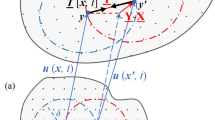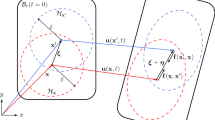Abstract
The peridynamics is a new meshless method, which has developed rapidly in recent years because of its superiority in dealing with discontinuity problems. In this paper, we established elastoplastic constitutive relations of finite deformation using Jaumann stress rate, Almansi strain rate, von Mises yield criteria, associated flow and isotropic hardening rule under the framework of non-ordinary state-based peridynamics. Further, the updated Lagrange solution method to the constitutive relation has also been proposed. We applied the solution to simulate the large elastoplastic tensile deformation of a rod and necking of a cylindrical bar, and the results are consistent with the analytical solution and the experimental results, separately. Our findings prove that the theory and method proposed in this paper are applicable to the analysis of elastoplastic finite deformation.
















Similar content being viewed by others
References
Silling SA, Askari A (2014) Peridynamic model for fatigue cracking. Report
Breitenfeld MS, Geubelle PH, Weckner O, Silling SA (2014) Non-ordinary state-based peridynamic analysis of stationary crack problems. Comput Methods Appl Mech Eng 272(15):233–250. https://doi.org/10.1016/j.cma.2014.01.002
Wang XC (1997) Fundamentals and numerical methods of finite element m. Tsinghua University Press, Bei**g
Silling SA, Bobaru F (2005) Peridynamic modeling of membranes and fibers. Int J Non-Linear Mech 40(2–3):395–409. https://doi.org/10.1016/j.ijnonlinmec.2004.08.004
Bang DJ, Madenci E (2017) Peridynamic modeling of hyperelastic membrane deformation. J Eng MaterTechnol 139(3):1–33. https://doi.org/10.1115/1.4035875
Huang Y, Oterkus S, Hou H, Oterkus E, Wei Z, Zhang S (2019) Peridynamic model for visco-hyperelastic material deformation in different strain rates. Contin Mech Thermodyn. https://doi.org/10.1007/s00161-019-00849-0
Nguyen CT, Oterkus S (2020) Ordinary state-based peridynamic model for geometrically nonlinear analysis. Eng Fract Mech 224:1–46. https://doi.org/10.1016/j.engfracmech.2019.106750
Roy P, Behera D, Madenci E (2020) Peridynamic simulation of finite elastic deformation and rupture in polymers. Eng Fract Mech 236:1–34. https://doi.org/10.1016/j.engfracmech.2020.107226
Behera D, Roy P, Madenci E (2020) Peridynamic correspondence model for finite elastic deformation and rupture in Neo-Hookean materials. Int J Non-Linear Mech 126:1–17. https://doi.org/10.1016/j.ijnonlinmec.2020.103564
Hashim NA, Coombs WM, Augarde CE, Hattori G (2020) An implicit non-ordinary state-based peridynamics with stabilised correspondence material model for finite deformation analysis. Comput Methods Appl Mech Eng 371:1–33. https://doi.org/10.1016/j.cma.2020.113304
Bergel GL, Li S (2016) The total and updated lagrangian formulations of state-based peridynamics. Comput Mech 58(2):351–370. https://doi.org/10.1007/s00466-016-1297-8
Foster JT, Xu X (2018) A generalized, ordinary, finite deformation constitutive correspondence model for peridynamics. Int J Solids Struct. https://doi.org/10.1016/j.ijsolstr.2018.02.026
Mitchell JA (2011) A nonlocal ordinary state-based plasticity model for peridynamics. Report
Asgari M, Kouchakzadeh MA (2019) An equivalent von mises stress and corresponding equivalent plastic strain for elastic plastic ordinary peridynamics. Meccanica 54(7):1001–1014. https://doi.org/10.1007/s11012-019-00975-8
Ahmadi M, Hosseini-Toudeshky H, Sadighi M (2020) Peridynamic micromechanical modeling of plastic deformation and progressive damage prediction in dual-phase materials. Eng Fract Mech 235:1–14. https://doi.org/10.1016/j.engfracmech.2020.107179
Madenci E, Oterkus S (2016) Ordinary state-based peridynamics for plastic deformation according to von Mises yield criteria with isotropic hardening. J Mech Phys Solids 86:192–219. https://doi.org/10.1016/j.jmps.2015.09.016
Pashazad H, Kharazi M (2019) A peridynamic plastic model based on von Mises criteria with isotropic, kinematic and mixed hardenings under cyclic loading. Int J Mech Sci 156:182–204. https://doi.org/10.1016/j.ijmecsci.2019.03.033
Lammi CJ, Vogler TJ (2014) A nonlocal peridynamic plasticity model for the dynamic flow and fracture of concrete. Report
Li P (2018) Peridynamic damage simulation method and its application on crack propagation analysis of PBX energetic materials
Gu X, Zhang Q, Madenci E (2019) Non-ordinary state-based peridynamic simulation of elastoplastic deformation and dynamic cracking of polycrystal. Eng Fract Mech 218:1–19. https://doi.org/10.1016/j.engfracmech.2019.106568
Foster JT, Silling SA, Chen WW (2010) Viscoplasticity using peridynamics. Int J Numer Methods Eng 81(10):1242–1258. https://doi.org/10.1002/nme.2725
Amani J, Oterkus E, Areias P, Zi G, Nguyen-Thoi T, Rabczuk T (2016) A non-ordinary state-based peridynamics formulation for thermoplastic fracture. Int J Impact Eng 87:83–94. https://doi.org/10.1016/j.ijimpeng.2015.06.019
Wang H, Xu Y, Huang D (2019) A non-ordinary state-based peridynamic formulation for thermo-visco-plastic deformation and impact fracture. Int J Mech Sci 159:336–344. https://doi.org/10.1016/j.ijmecsci.2019.06.008
Behzadinasab M, Foster JT (2020) Revisiting the third Sandia Fracture Challenge: a bond-associated, semi-Lagrangian peridynamic approach to modeling large deformation and ductile fracture. Int J Fract 224(2):261–267
Behzadinasab M, Foster JT (2020) A semi-Lagrangian constitutive correspondence framework for peridynamics. J Mech Phys Solids 137:1–24. https://doi.org/10.1016/j.jmps.2019.103862
Silling SA, Epton M, Weckner O, Xu J, Askari E (2007) Peridynamic states and constitutive modeling. J Elast 88(2):151–184. https://doi.org/10.1007/s10659-007-9125-1
Tupek MR, Rimoli JJ, Radovitzky R (2013) An approach for incorporating classical continuum damage models in state-based peridynamics. Comput Methods Appl Mech Eng 263:20–26. https://doi.org/10.1016/j.cma.2013.04.012
**e YL (1998) Finite deformation consolidation theory and its finite element method. China Communications Press, Bei**g
Kang G, Gao Q, Yang X (2002) A visco–plastic constitutive model incorporated with cyclic hardening for uniaxial/multiaxial ratcheting of SS304 stainless steel at room temperature. Mech Mater 34(9):521–531
Hartmann S, Luhrs G, Haupt P (1997) An efficient stress algorithm with applications in viscoplasticity and plasticity. Int J Numer Methods Eng 40(6):991–1013. https://doi.org/10.1002/(sici)1097-0207(19970330)40:6<991::Aid-nme98>3.0.Co;2-h
**ng J, Jia-ju Y, Quan T (1983) A finite element analysis of bar and plate specimen necking. Acta Mech Solida Sin 4:532–542
Acknowledgements
This study was funded by the NSAF of China (Grant No. U183010034).
Author information
Authors and Affiliations
Corresponding author
Ethics declarations
Conflict of interest
The authors declare that they have no conflict of interest.
Additional information
Publisher's Note
Springer Nature remains neutral with regard to jurisdictional claims in published maps and institutional affiliations.
Rights and permissions
Springer Nature or its licensor (e.g. a society or other partner) holds exclusive rights to this article under a publishing agreement with the author(s) or other rightsholder(s); author self-archiving of the accepted manuscript version of this article is solely governed by the terms of such publishing agreement and applicable law.
About this article
Cite this article
Li, H., Hao, Z., Li, P. et al. Elastoplastic theory of finite deformation and its solution method for non-ordinary state-based peridynamics. Meccanica 57, 2809–2820 (2022). https://doi.org/10.1007/s11012-022-01600-x
Received:
Accepted:
Published:
Issue Date:
DOI: https://doi.org/10.1007/s11012-022-01600-x




